A Study on Forensic Evidence in the Context of Nepal: B.A. LL.B.
VerifiedAdded on 2022/03/22
|48
|15810
|155
Report
AI Summary
This seminar report, submitted by Sony Baniya of Nepal Law Campus, provides a comprehensive study on forensic evidence in the context of Nepal. It delves into the general background of forensic science, its application in criminal investigations, and the evolution of forensic techniques, including DNA profiling. The report addresses the statement of the problem by analyzing the court's acceptance of forensic evidence and its role in enforcing laws. Objectives include analyzing the admissibility of forensic evidence, examining relevant Supreme Court cases, understanding the legal aspects, and identifying forensic science institutions in Nepal. The report also provides a literature review and discusses the need for a specific statutory mechanism for forensic science in Nepal, highlighting the existing reliance on various legislations and the need for modern technology and scientific principles in judicial decision-making. The study aims to analyze the trend related to the application of forensic evidence by courts in Nepal.
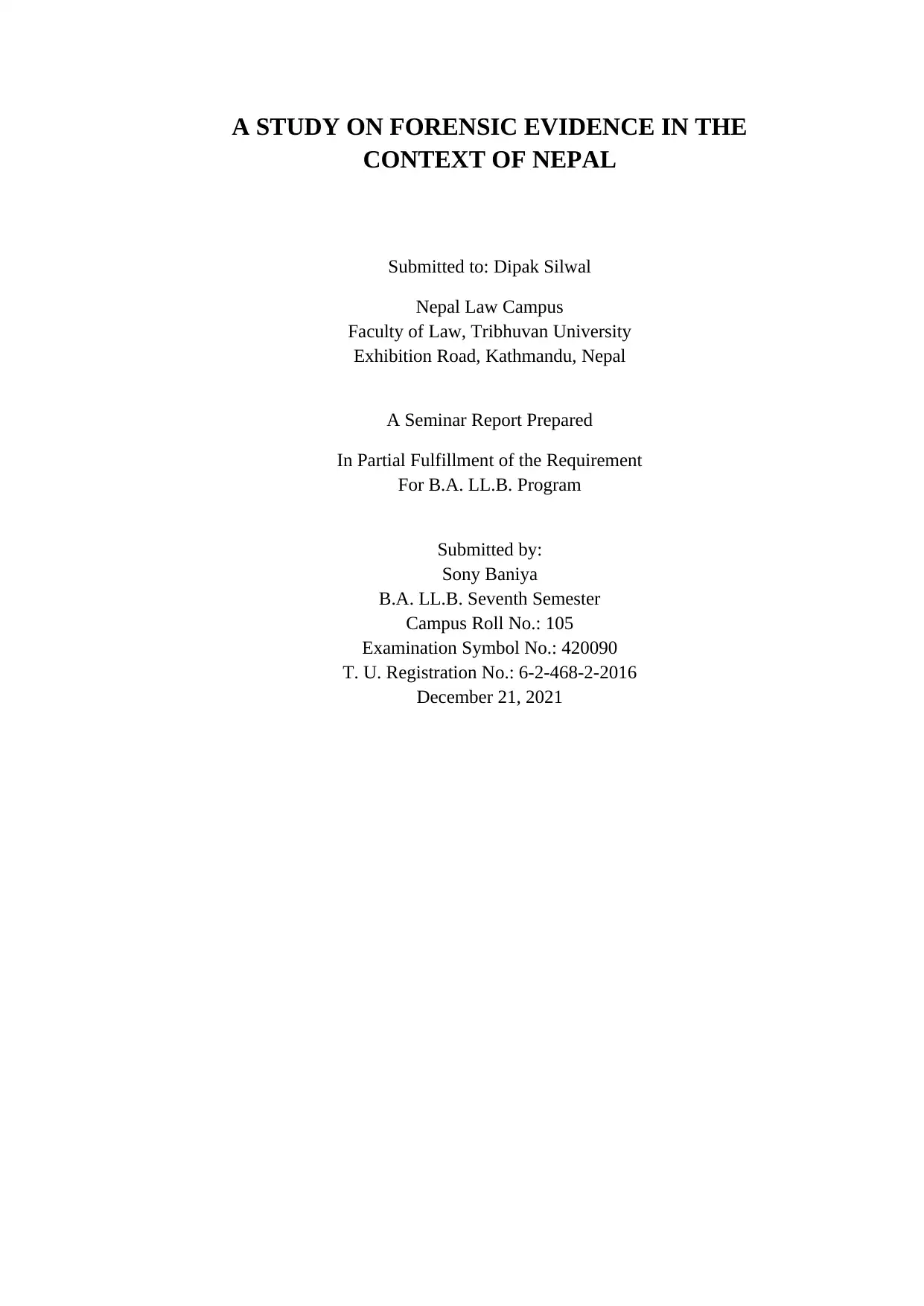
A STUDY ON FORENSIC EVIDENCE IN THE
CONTEXT OF NEPAL
Submitted to: Dipak Silwal
Nepal Law Campus
Faculty of Law, Tribhuvan University
Exhibition Road, Kathmandu, Nepal
A Seminar Report Prepared
In Partial Fulfillment of the Requirement
For B.A. LL.B. Program
Submitted by:
Sony Baniya
B.A. LL.B. Seventh Semester
Campus Roll No.: 105
Examination Symbol No.: 420090
T. U. Registration No.: 6-2-468-2-2016
December 21, 2021
CONTEXT OF NEPAL
Submitted to: Dipak Silwal
Nepal Law Campus
Faculty of Law, Tribhuvan University
Exhibition Road, Kathmandu, Nepal
A Seminar Report Prepared
In Partial Fulfillment of the Requirement
For B.A. LL.B. Program
Submitted by:
Sony Baniya
B.A. LL.B. Seventh Semester
Campus Roll No.: 105
Examination Symbol No.: 420090
T. U. Registration No.: 6-2-468-2-2016
December 21, 2021
Paraphrase This Document
Need a fresh take? Get an instant paraphrase of this document with our AI Paraphraser
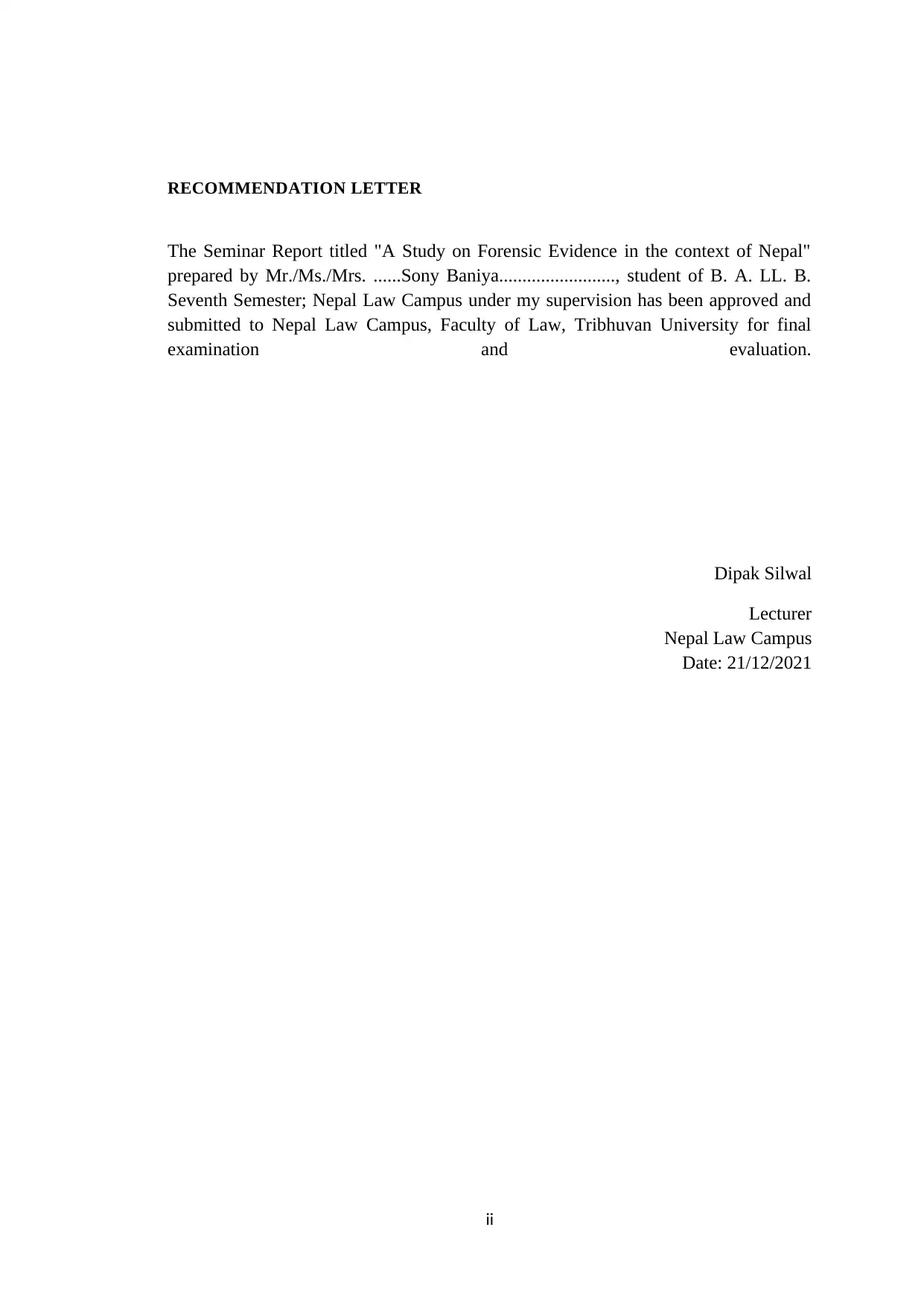
RECOMMENDATION LETTER
The Seminar Report titled "A Study on Forensic Evidence in the context of Nepal"
prepared by Mr./Ms./Mrs. ......Sony Baniya........................., student of B. A. LL. B.
Seventh Semester; Nepal Law Campus under my supervision has been approved and
submitted to Nepal Law Campus, Faculty of Law, Tribhuvan University for final
examination and evaluation.
Dipak Silwal
Lecturer
Nepal Law Campus
Date: 21/12/2021
ii
The Seminar Report titled "A Study on Forensic Evidence in the context of Nepal"
prepared by Mr./Ms./Mrs. ......Sony Baniya........................., student of B. A. LL. B.
Seventh Semester; Nepal Law Campus under my supervision has been approved and
submitted to Nepal Law Campus, Faculty of Law, Tribhuvan University for final
examination and evaluation.
Dipak Silwal
Lecturer
Nepal Law Campus
Date: 21/12/2021
ii
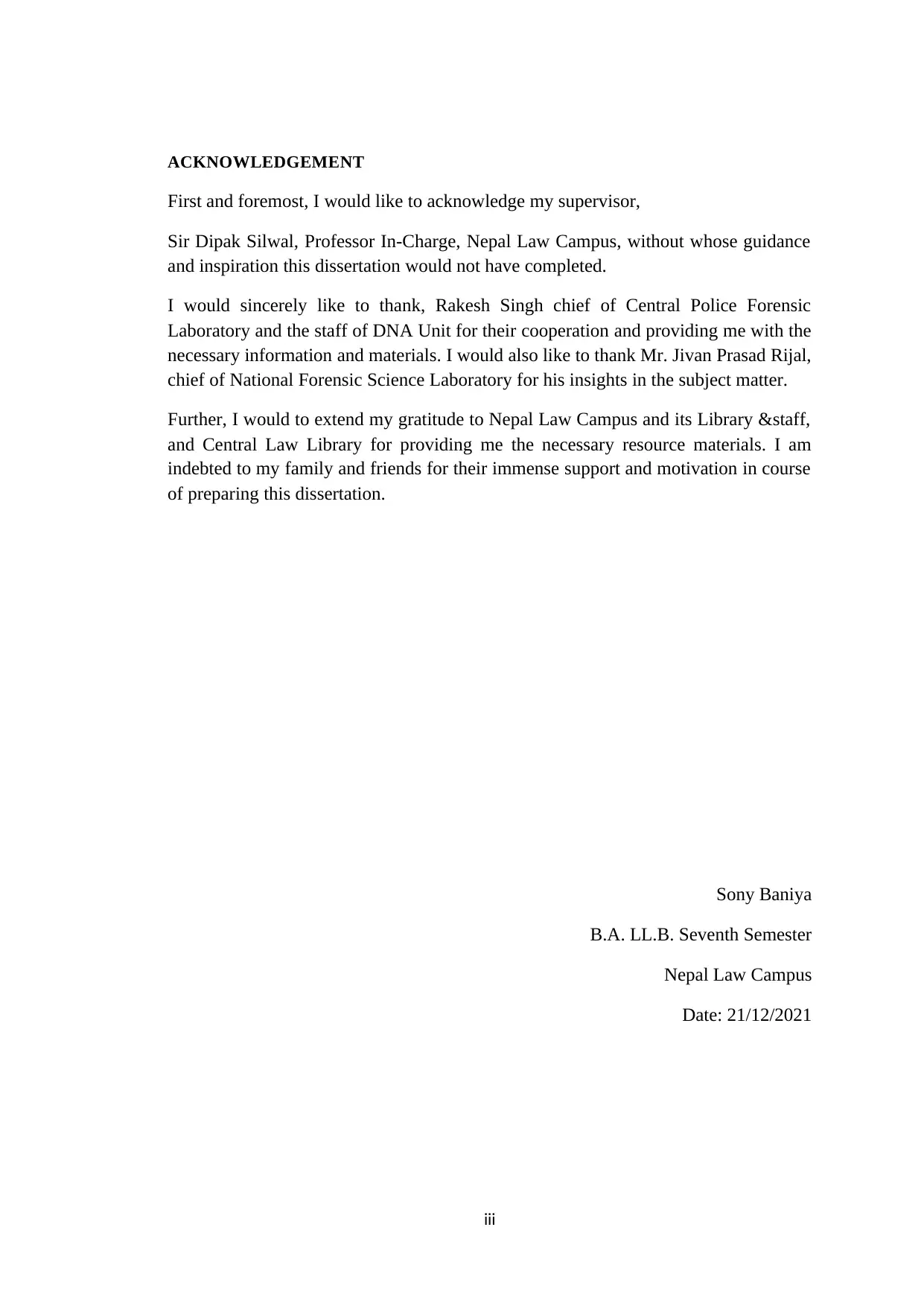
ACKNOWLEDGEMENT
First and foremost, I would like to acknowledge my supervisor,
Sir Dipak Silwal, Professor In-Charge, Nepal Law Campus, without whose guidance
and inspiration this dissertation would not have completed.
I would sincerely like to thank, Rakesh Singh chief of Central Police Forensic
Laboratory and the staff of DNA Unit for their cooperation and providing me with the
necessary information and materials. I would also like to thank Mr. Jivan Prasad Rijal,
chief of National Forensic Science Laboratory for his insights in the subject matter.
Further, I would to extend my gratitude to Nepal Law Campus and its Library &staff,
and Central Law Library for providing me the necessary resource materials. I am
indebted to my family and friends for their immense support and motivation in course
of preparing this dissertation.
Sony Baniya
B.A. LL.B. Seventh Semester
Nepal Law Campus
Date: 21/12/2021
iii
First and foremost, I would like to acknowledge my supervisor,
Sir Dipak Silwal, Professor In-Charge, Nepal Law Campus, without whose guidance
and inspiration this dissertation would not have completed.
I would sincerely like to thank, Rakesh Singh chief of Central Police Forensic
Laboratory and the staff of DNA Unit for their cooperation and providing me with the
necessary information and materials. I would also like to thank Mr. Jivan Prasad Rijal,
chief of National Forensic Science Laboratory for his insights in the subject matter.
Further, I would to extend my gratitude to Nepal Law Campus and its Library &staff,
and Central Law Library for providing me the necessary resource materials. I am
indebted to my family and friends for their immense support and motivation in course
of preparing this dissertation.
Sony Baniya
B.A. LL.B. Seventh Semester
Nepal Law Campus
Date: 21/12/2021
iii
⊘ This is a preview!⊘
Do you want full access?
Subscribe today to unlock all pages.

Trusted by 1+ million students worldwide
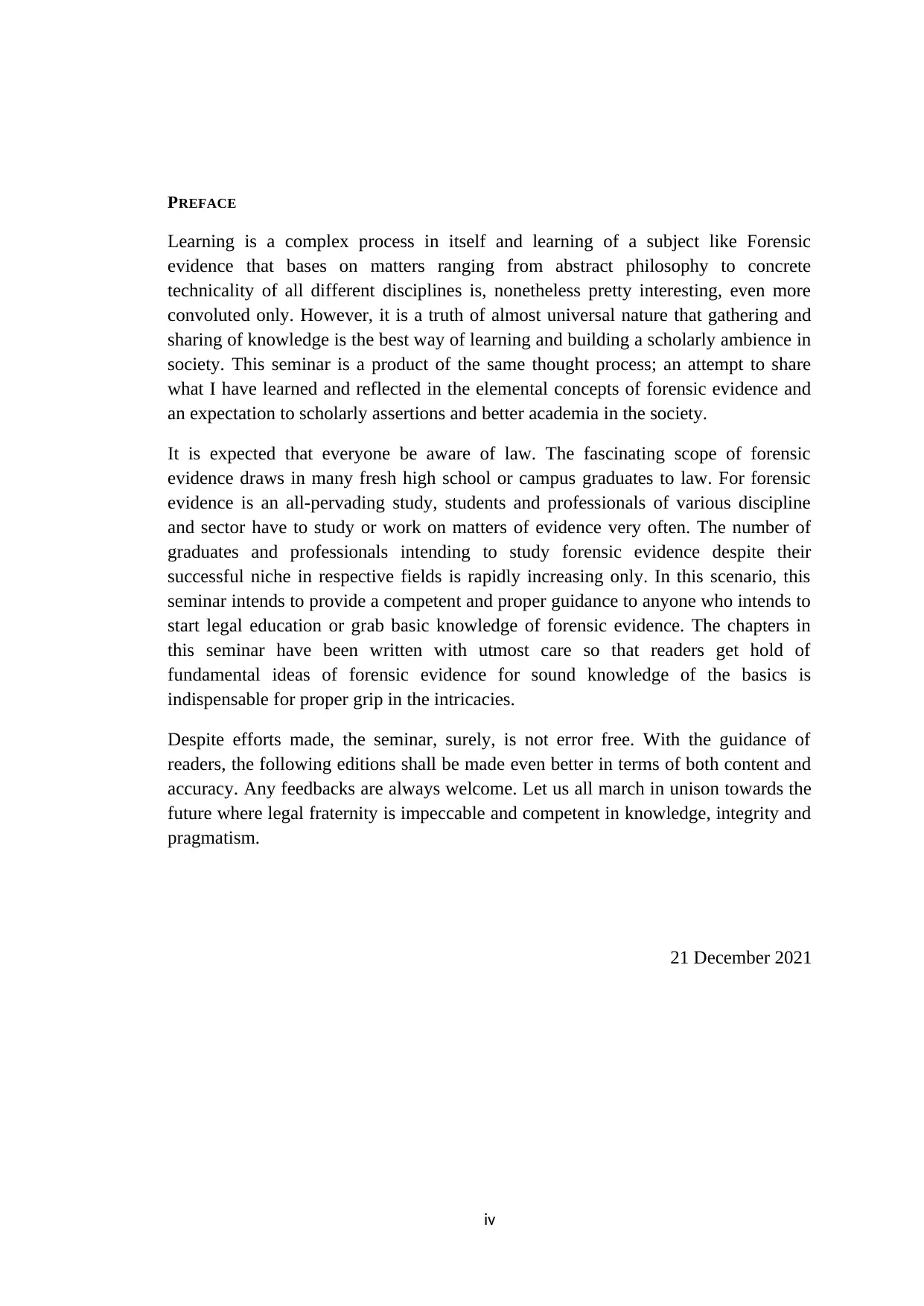
PREFACE
Learning is a complex process in itself and learning of a subject like Forensic
evidence that bases on matters ranging from abstract philosophy to concrete
technicality of all different disciplines is, nonetheless pretty interesting, even more
convoluted only. However, it is a truth of almost universal nature that gathering and
sharing of knowledge is the best way of learning and building a scholarly ambience in
society. This seminar is a product of the same thought process; an attempt to share
what I have learned and reflected in the elemental concepts of forensic evidence and
an expectation to scholarly assertions and better academia in the society.
It is expected that everyone be aware of law. The fascinating scope of forensic
evidence draws in many fresh high school or campus graduates to law. For forensic
evidence is an all-pervading study, students and professionals of various discipline
and sector have to study or work on matters of evidence very often. The number of
graduates and professionals intending to study forensic evidence despite their
successful niche in respective fields is rapidly increasing only. In this scenario, this
seminar intends to provide a competent and proper guidance to anyone who intends to
start legal education or grab basic knowledge of forensic evidence. The chapters in
this seminar have been written with utmost care so that readers get hold of
fundamental ideas of forensic evidence for sound knowledge of the basics is
indispensable for proper grip in the intricacies.
Despite efforts made, the seminar, surely, is not error free. With the guidance of
readers, the following editions shall be made even better in terms of both content and
accuracy. Any feedbacks are always welcome. Let us all march in unison towards the
future where legal fraternity is impeccable and competent in knowledge, integrity and
pragmatism.
21 December 2021
iv
Learning is a complex process in itself and learning of a subject like Forensic
evidence that bases on matters ranging from abstract philosophy to concrete
technicality of all different disciplines is, nonetheless pretty interesting, even more
convoluted only. However, it is a truth of almost universal nature that gathering and
sharing of knowledge is the best way of learning and building a scholarly ambience in
society. This seminar is a product of the same thought process; an attempt to share
what I have learned and reflected in the elemental concepts of forensic evidence and
an expectation to scholarly assertions and better academia in the society.
It is expected that everyone be aware of law. The fascinating scope of forensic
evidence draws in many fresh high school or campus graduates to law. For forensic
evidence is an all-pervading study, students and professionals of various discipline
and sector have to study or work on matters of evidence very often. The number of
graduates and professionals intending to study forensic evidence despite their
successful niche in respective fields is rapidly increasing only. In this scenario, this
seminar intends to provide a competent and proper guidance to anyone who intends to
start legal education or grab basic knowledge of forensic evidence. The chapters in
this seminar have been written with utmost care so that readers get hold of
fundamental ideas of forensic evidence for sound knowledge of the basics is
indispensable for proper grip in the intricacies.
Despite efforts made, the seminar, surely, is not error free. With the guidance of
readers, the following editions shall be made even better in terms of both content and
accuracy. Any feedbacks are always welcome. Let us all march in unison towards the
future where legal fraternity is impeccable and competent in knowledge, integrity and
pragmatism.
21 December 2021
iv
Paraphrase This Document
Need a fresh take? Get an instant paraphrase of this document with our AI Paraphraser
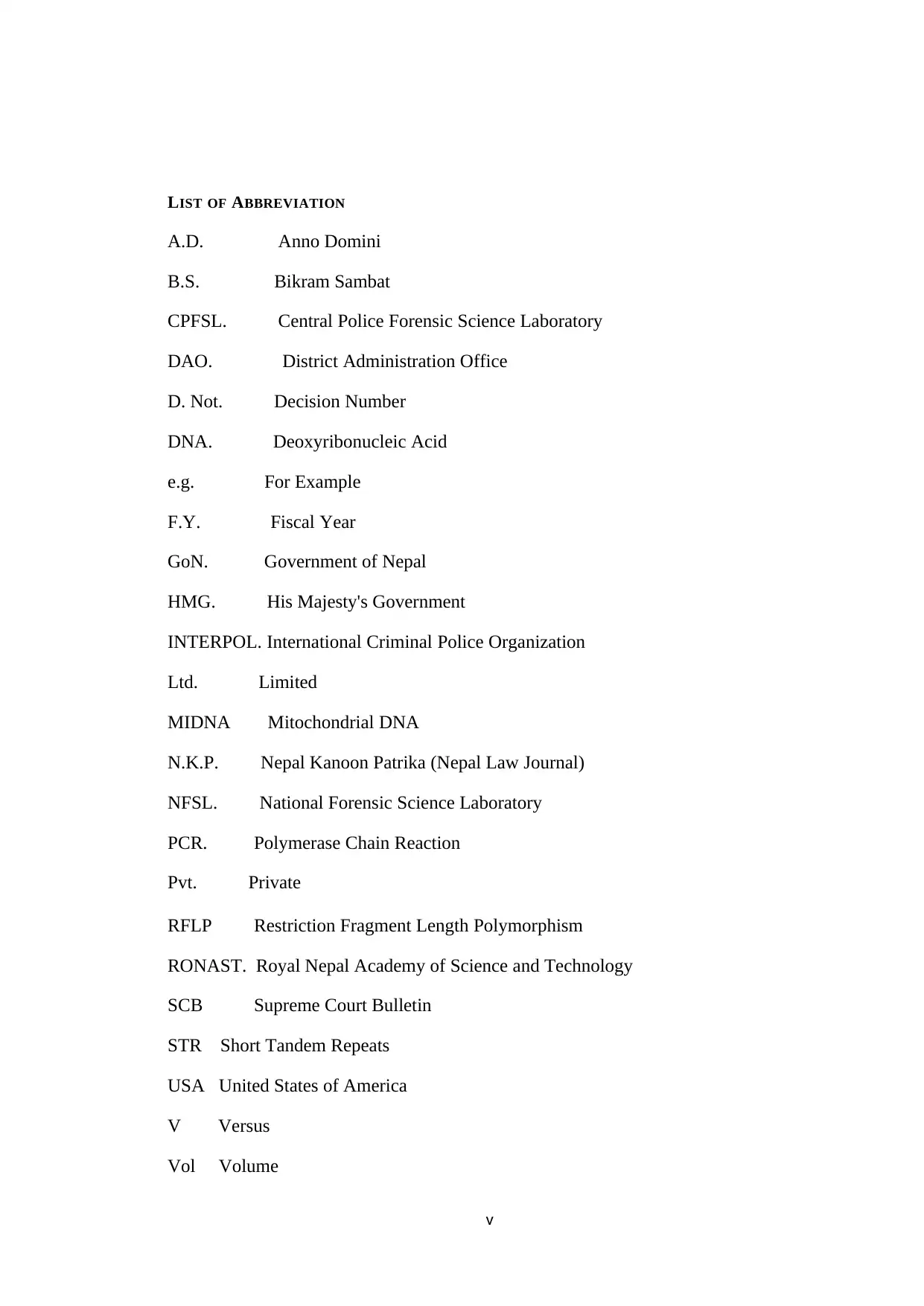
LIST OF ABBREVIATION
A.D. Anno Domini
B.S. Bikram Sambat
CPFSL. Central Police Forensic Science Laboratory
DAO. District Administration Office
D. Not. Decision Number
DNA. Deoxyribonucleic Acid
e.g. For Example
F.Y. Fiscal Year
GoN. Government of Nepal
HMG. His Majesty's Government
INTERPOL. International Criminal Police Organization
Ltd. Limited
MIDNA Mitochondrial DNA
N.K.P. Nepal Kanoon Patrika (Nepal Law Journal)
NFSL. National Forensic Science Laboratory
PCR. Polymerase Chain Reaction
Pvt. Private
RFLP Restriction Fragment Length Polymorphism
RONAST. Royal Nepal Academy of Science and Technology
SCB Supreme Court Bulletin
STR Short Tandem Repeats
USA United States of America
V Versus
Vol Volume
v
A.D. Anno Domini
B.S. Bikram Sambat
CPFSL. Central Police Forensic Science Laboratory
DAO. District Administration Office
D. Not. Decision Number
DNA. Deoxyribonucleic Acid
e.g. For Example
F.Y. Fiscal Year
GoN. Government of Nepal
HMG. His Majesty's Government
INTERPOL. International Criminal Police Organization
Ltd. Limited
MIDNA Mitochondrial DNA
N.K.P. Nepal Kanoon Patrika (Nepal Law Journal)
NFSL. National Forensic Science Laboratory
PCR. Polymerase Chain Reaction
Pvt. Private
RFLP Restriction Fragment Length Polymorphism
RONAST. Royal Nepal Academy of Science and Technology
SCB Supreme Court Bulletin
STR Short Tandem Repeats
USA United States of America
V Versus
Vol Volume
v

VNTR Variable Number Tandem Repeats
vi
vi
⊘ This is a preview!⊘
Do you want full access?
Subscribe today to unlock all pages.

Trusted by 1+ million students worldwide
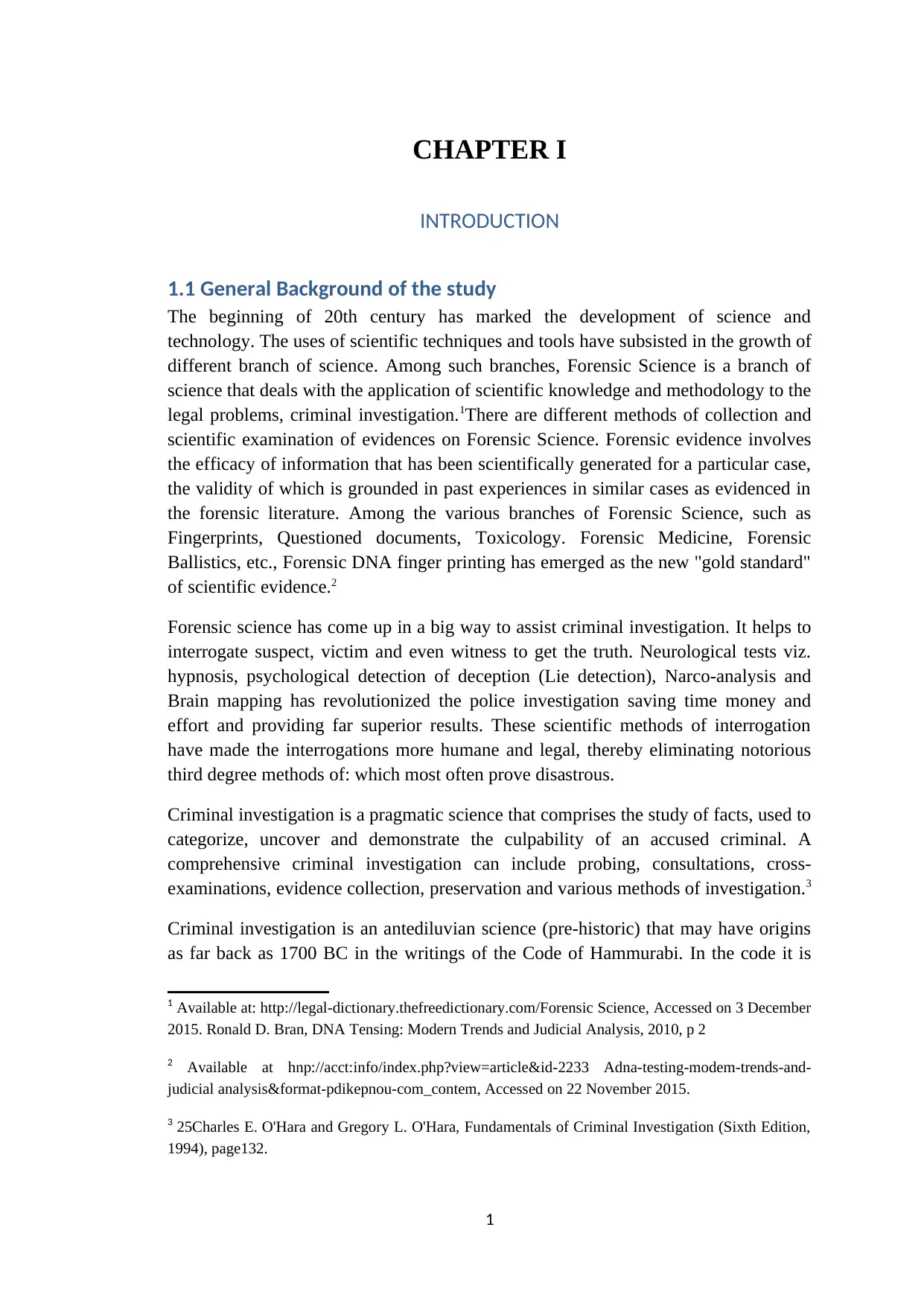
CHAPTER Ι
INTRODUCTION
1.1 General Background of the study
The beginning of 20th century has marked the development of science and
technology. The uses of scientific techniques and tools have subsisted in the growth of
different branch of science. Among such branches, Forensic Science is a branch of
science that deals with the application of scientific knowledge and methodology to the
legal problems, criminal investigation.1There are different methods of collection and
scientific examination of evidences on Forensic Science. Forensic evidence involves
the efficacy of information that has been scientifically generated for a particular case,
the validity of which is grounded in past experiences in similar cases as evidenced in
the forensic literature. Among the various branches of Forensic Science, such as
Fingerprints, Questioned documents, Toxicology. Forensic Medicine, Forensic
Ballistics, etc., Forensic DNA finger printing has emerged as the new "gold standard"
of scientific evidence.2
Forensic science has come up in a big way to assist criminal investigation. It helps to
interrogate suspect, victim and even witness to get the truth. Neurological tests viz.
hypnosis, psychological detection of deception (Lie detection), Narco-analysis and
Brain mapping has revolutionized the police investigation saving time money and
effort and providing far superior results. These scientific methods of interrogation
have made the interrogations more humane and legal, thereby eliminating notorious
third degree methods of: which most often prove disastrous.
Criminal investigation is a pragmatic science that comprises the study of facts, used to
categorize, uncover and demonstrate the culpability of an accused criminal. A
comprehensive criminal investigation can include probing, consultations, cross-
examinations, evidence collection, preservation and various methods of investigation.3
Criminal investigation is an antediluvian science (pre-historic) that may have origins
as far back as 1700 BC in the writings of the Code of Hammurabi. In the code it is
1 Available at: http://legal-dictionary.thefreedictionary.com/Forensic Science, Accessed on 3 December
2015. Ronald D. Bran, DNA Tensing: Modern Trends and Judicial Analysis, 2010, p 2
2 Available at hnp://acct:info/index.php?view=article&id-2233 Adna-testing-modem-trends-and-
judicial analysis&format-pdikepnou-com_contem, Accessed on 22 November 2015.
3 25Charles E. O'Hara and Gregory L. O'Hara, Fundamentals of Criminal Investigation (Sixth Edition,
1994), page132.
1
INTRODUCTION
1.1 General Background of the study
The beginning of 20th century has marked the development of science and
technology. The uses of scientific techniques and tools have subsisted in the growth of
different branch of science. Among such branches, Forensic Science is a branch of
science that deals with the application of scientific knowledge and methodology to the
legal problems, criminal investigation.1There are different methods of collection and
scientific examination of evidences on Forensic Science. Forensic evidence involves
the efficacy of information that has been scientifically generated for a particular case,
the validity of which is grounded in past experiences in similar cases as evidenced in
the forensic literature. Among the various branches of Forensic Science, such as
Fingerprints, Questioned documents, Toxicology. Forensic Medicine, Forensic
Ballistics, etc., Forensic DNA finger printing has emerged as the new "gold standard"
of scientific evidence.2
Forensic science has come up in a big way to assist criminal investigation. It helps to
interrogate suspect, victim and even witness to get the truth. Neurological tests viz.
hypnosis, psychological detection of deception (Lie detection), Narco-analysis and
Brain mapping has revolutionized the police investigation saving time money and
effort and providing far superior results. These scientific methods of interrogation
have made the interrogations more humane and legal, thereby eliminating notorious
third degree methods of: which most often prove disastrous.
Criminal investigation is a pragmatic science that comprises the study of facts, used to
categorize, uncover and demonstrate the culpability of an accused criminal. A
comprehensive criminal investigation can include probing, consultations, cross-
examinations, evidence collection, preservation and various methods of investigation.3
Criminal investigation is an antediluvian science (pre-historic) that may have origins
as far back as 1700 BC in the writings of the Code of Hammurabi. In the code it is
1 Available at: http://legal-dictionary.thefreedictionary.com/Forensic Science, Accessed on 3 December
2015. Ronald D. Bran, DNA Tensing: Modern Trends and Judicial Analysis, 2010, p 2
2 Available at hnp://acct:info/index.php?view=article&id-2233 Adna-testing-modem-trends-and-
judicial analysis&format-pdikepnou-com_contem, Accessed on 22 November 2015.
3 25Charles E. O'Hara and Gregory L. O'Hara, Fundamentals of Criminal Investigation (Sixth Edition,
1994), page132.
1
Paraphrase This Document
Need a fresh take? Get an instant paraphrase of this document with our AI Paraphraser
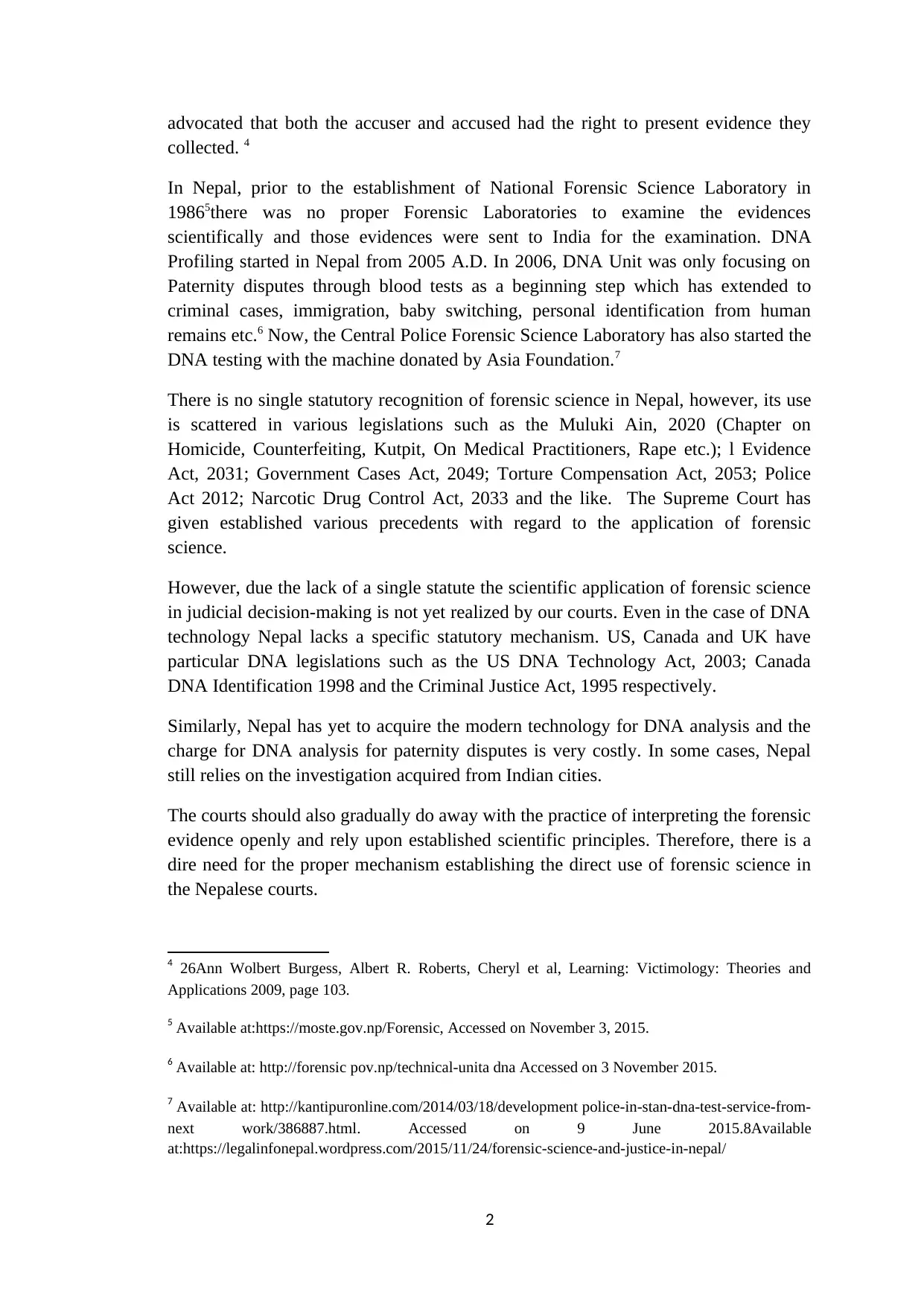
advocated that both the accuser and accused had the right to present evidence they
collected. 4
In Nepal, prior to the establishment of National Forensic Science Laboratory in
19865there was no proper Forensic Laboratories to examine the evidences
scientifically and those evidences were sent to India for the examination. DNA
Profiling started in Nepal from 2005 A.D. In 2006, DNA Unit was only focusing on
Paternity disputes through blood tests as a beginning step which has extended to
criminal cases, immigration, baby switching, personal identification from human
remains etc.6 Now, the Central Police Forensic Science Laboratory has also started the
DNA testing with the machine donated by Asia Foundation.7
There is no single statutory recognition of forensic science in Nepal, however, its use
is scattered in various legislations such as the Muluki Ain, 2020 (Chapter on
Homicide, Counterfeiting, Kutpit, On Medical Practitioners, Rape etc.); l Evidence
Act, 2031; Government Cases Act, 2049; Torture Compensation Act, 2053; Police
Act 2012; Narcotic Drug Control Act, 2033 and the like. The Supreme Court has
given established various precedents with regard to the application of forensic
science.
However, due the lack of a single statute the scientific application of forensic science
in judicial decision-making is not yet realized by our courts. Even in the case of DNA
technology Nepal lacks a specific statutory mechanism. US, Canada and UK have
particular DNA legislations such as the US DNA Technology Act, 2003; Canada
DNA Identification 1998 and the Criminal Justice Act, 1995 respectively.
Similarly, Nepal has yet to acquire the modern technology for DNA analysis and the
charge for DNA analysis for paternity disputes is very costly. In some cases, Nepal
still relies on the investigation acquired from Indian cities.
The courts should also gradually do away with the practice of interpreting the forensic
evidence openly and rely upon established scientific principles. Therefore, there is a
dire need for the proper mechanism establishing the direct use of forensic science in
the Nepalese courts.
4 26Ann Wolbert Burgess, Albert R. Roberts, Cheryl et al, Learning: Victimology: Theories and
Applications 2009, page 103.
5 Available at:https://moste.gov.np/Forensic, Accessed on November 3, 2015.
6 Available at: http://forensic pov.np/technical-unita dna Accessed on 3 November 2015.
7 Available at: http://kantipuronline.com/2014/03/18/development police-in-stan-dna-test-service-from-
next work/386887.html. Accessed on 9 June 2015.8Available
at:https://legalinfonepal.wordpress.com/2015/11/24/forensic-science-and-justice-in-nepal/
2
collected. 4
In Nepal, prior to the establishment of National Forensic Science Laboratory in
19865there was no proper Forensic Laboratories to examine the evidences
scientifically and those evidences were sent to India for the examination. DNA
Profiling started in Nepal from 2005 A.D. In 2006, DNA Unit was only focusing on
Paternity disputes through blood tests as a beginning step which has extended to
criminal cases, immigration, baby switching, personal identification from human
remains etc.6 Now, the Central Police Forensic Science Laboratory has also started the
DNA testing with the machine donated by Asia Foundation.7
There is no single statutory recognition of forensic science in Nepal, however, its use
is scattered in various legislations such as the Muluki Ain, 2020 (Chapter on
Homicide, Counterfeiting, Kutpit, On Medical Practitioners, Rape etc.); l Evidence
Act, 2031; Government Cases Act, 2049; Torture Compensation Act, 2053; Police
Act 2012; Narcotic Drug Control Act, 2033 and the like. The Supreme Court has
given established various precedents with regard to the application of forensic
science.
However, due the lack of a single statute the scientific application of forensic science
in judicial decision-making is not yet realized by our courts. Even in the case of DNA
technology Nepal lacks a specific statutory mechanism. US, Canada and UK have
particular DNA legislations such as the US DNA Technology Act, 2003; Canada
DNA Identification 1998 and the Criminal Justice Act, 1995 respectively.
Similarly, Nepal has yet to acquire the modern technology for DNA analysis and the
charge for DNA analysis for paternity disputes is very costly. In some cases, Nepal
still relies on the investigation acquired from Indian cities.
The courts should also gradually do away with the practice of interpreting the forensic
evidence openly and rely upon established scientific principles. Therefore, there is a
dire need for the proper mechanism establishing the direct use of forensic science in
the Nepalese courts.
4 26Ann Wolbert Burgess, Albert R. Roberts, Cheryl et al, Learning: Victimology: Theories and
Applications 2009, page 103.
5 Available at:https://moste.gov.np/Forensic, Accessed on November 3, 2015.
6 Available at: http://forensic pov.np/technical-unita dna Accessed on 3 November 2015.
7 Available at: http://kantipuronline.com/2014/03/18/development police-in-stan-dna-test-service-from-
next work/386887.html. Accessed on 9 June 2015.8Available
at:https://legalinfonepal.wordpress.com/2015/11/24/forensic-science-and-justice-in-nepal/
2
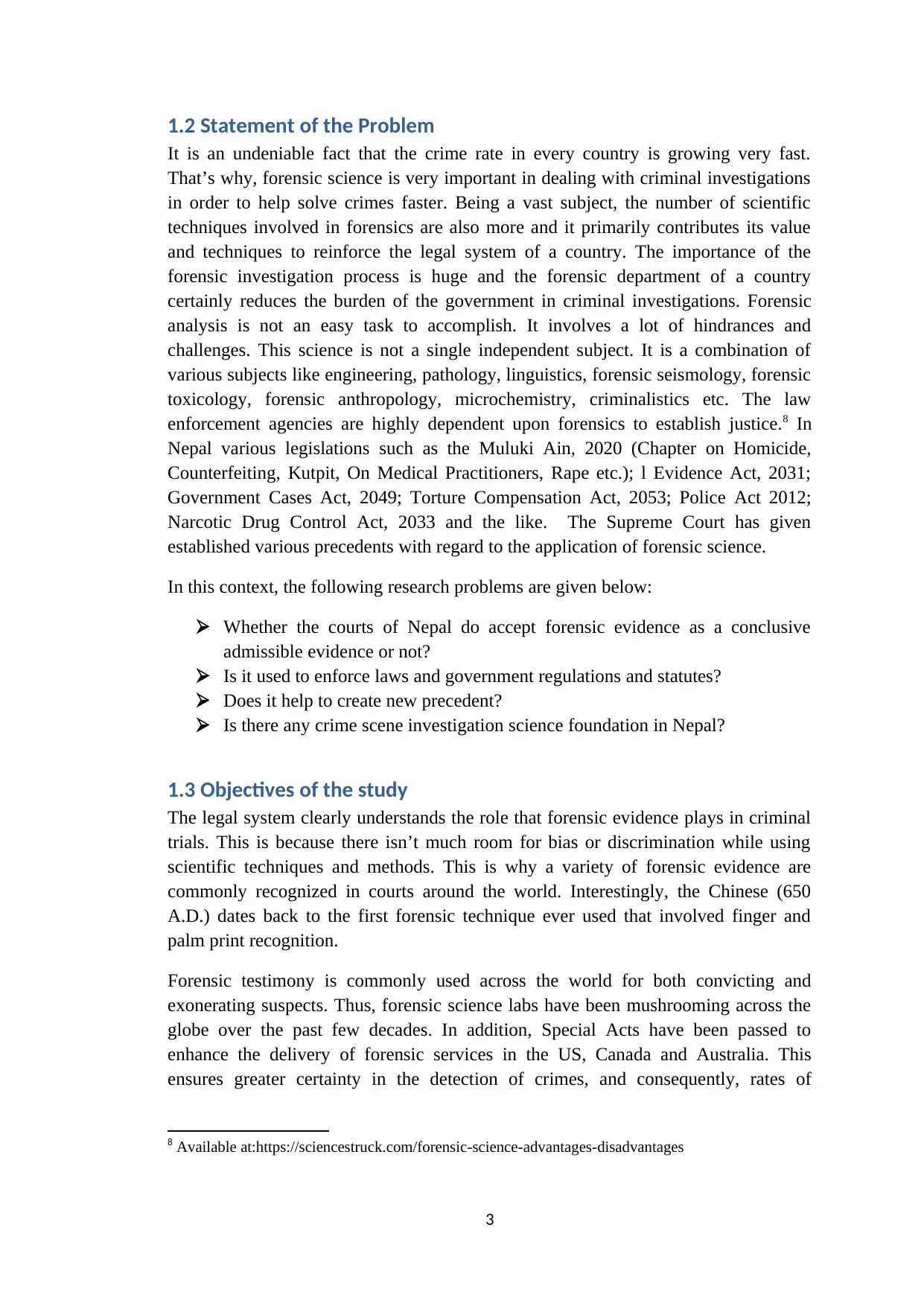
1.2 Statement of the Problem
It is an undeniable fact that the crime rate in every country is growing very fast.
That’s why, forensic science is very important in dealing with criminal investigations
in order to help solve crimes faster. Being a vast subject, the number of scientific
techniques involved in forensics are also more and it primarily contributes its value
and techniques to reinforce the legal system of a country. The importance of the
forensic investigation process is huge and the forensic department of a country
certainly reduces the burden of the government in criminal investigations. Forensic
analysis is not an easy task to accomplish. It involves a lot of hindrances and
challenges. This science is not a single independent subject. It is a combination of
various subjects like engineering, pathology, linguistics, forensic seismology, forensic
toxicology, forensic anthropology, microchemistry, criminalistics etc. The law
enforcement agencies are highly dependent upon forensics to establish justice.8 In
Nepal various legislations such as the Muluki Ain, 2020 (Chapter on Homicide,
Counterfeiting, Kutpit, On Medical Practitioners, Rape etc.); l Evidence Act, 2031;
Government Cases Act, 2049; Torture Compensation Act, 2053; Police Act 2012;
Narcotic Drug Control Act, 2033 and the like. The Supreme Court has given
established various precedents with regard to the application of forensic science.
In this context, the following research problems are given below:
Whether the courts of Nepal do accept forensic evidence as a conclusive
admissible evidence or not?
Is it used to enforce laws and government regulations and statutes?
Does it help to create new precedent?
Is there any crime scene investigation science foundation in Nepal?
1.3 Objectives of the study
The legal system clearly understands the role that forensic evidence plays in criminal
trials. This is because there isn’t much room for bias or discrimination while using
scientific techniques and methods. This is why a variety of forensic evidence are
commonly recognized in courts around the world. Interestingly, the Chinese (650
A.D.) dates back to the first forensic technique ever used that involved finger and
palm print recognition.
Forensic testimony is commonly used across the world for both convicting and
exonerating suspects. Thus, forensic science labs have been mushrooming across the
globe over the past few decades. In addition, Special Acts have been passed to
enhance the delivery of forensic services in the US, Canada and Australia. This
ensures greater certainty in the detection of crimes, and consequently, rates of
8 Available at:https://sciencestruck.com/forensic-science-advantages-disadvantages
3
It is an undeniable fact that the crime rate in every country is growing very fast.
That’s why, forensic science is very important in dealing with criminal investigations
in order to help solve crimes faster. Being a vast subject, the number of scientific
techniques involved in forensics are also more and it primarily contributes its value
and techniques to reinforce the legal system of a country. The importance of the
forensic investigation process is huge and the forensic department of a country
certainly reduces the burden of the government in criminal investigations. Forensic
analysis is not an easy task to accomplish. It involves a lot of hindrances and
challenges. This science is not a single independent subject. It is a combination of
various subjects like engineering, pathology, linguistics, forensic seismology, forensic
toxicology, forensic anthropology, microchemistry, criminalistics etc. The law
enforcement agencies are highly dependent upon forensics to establish justice.8 In
Nepal various legislations such as the Muluki Ain, 2020 (Chapter on Homicide,
Counterfeiting, Kutpit, On Medical Practitioners, Rape etc.); l Evidence Act, 2031;
Government Cases Act, 2049; Torture Compensation Act, 2053; Police Act 2012;
Narcotic Drug Control Act, 2033 and the like. The Supreme Court has given
established various precedents with regard to the application of forensic science.
In this context, the following research problems are given below:
Whether the courts of Nepal do accept forensic evidence as a conclusive
admissible evidence or not?
Is it used to enforce laws and government regulations and statutes?
Does it help to create new precedent?
Is there any crime scene investigation science foundation in Nepal?
1.3 Objectives of the study
The legal system clearly understands the role that forensic evidence plays in criminal
trials. This is because there isn’t much room for bias or discrimination while using
scientific techniques and methods. This is why a variety of forensic evidence are
commonly recognized in courts around the world. Interestingly, the Chinese (650
A.D.) dates back to the first forensic technique ever used that involved finger and
palm print recognition.
Forensic testimony is commonly used across the world for both convicting and
exonerating suspects. Thus, forensic science labs have been mushrooming across the
globe over the past few decades. In addition, Special Acts have been passed to
enhance the delivery of forensic services in the US, Canada and Australia. This
ensures greater certainty in the detection of crimes, and consequently, rates of
8 Available at:https://sciencestruck.com/forensic-science-advantages-disadvantages
3
⊘ This is a preview!⊘
Do you want full access?
Subscribe today to unlock all pages.

Trusted by 1+ million students worldwide
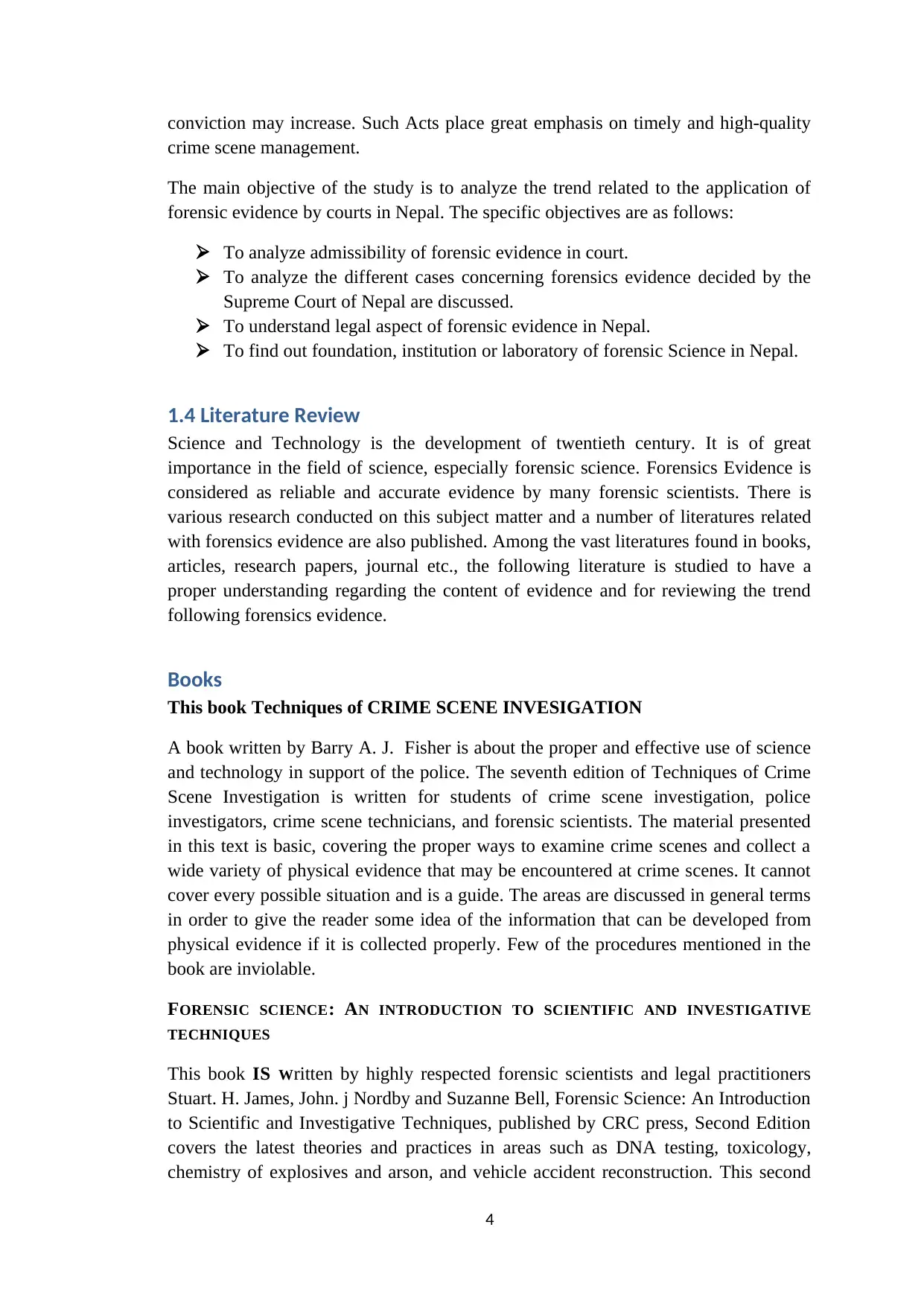
conviction may increase. Such Acts place great emphasis on timely and high-quality
crime scene management.
The main objective of the study is to analyze the trend related to the application of
forensic evidence by courts in Nepal. The specific objectives are as follows:
To analyze admissibility of forensic evidence in court.
To analyze the different cases concerning forensics evidence decided by the
Supreme Court of Nepal are discussed.
To understand legal aspect of forensic evidence in Nepal.
To find out foundation, institution or laboratory of forensic Science in Nepal.
1.4 Literature Review
Science and Technology is the development of twentieth century. It is of great
importance in the field of science, especially forensic science. Forensics Evidence is
considered as reliable and accurate evidence by many forensic scientists. There is
various research conducted on this subject matter and a number of literatures related
with forensics evidence are also published. Among the vast literatures found in books,
articles, research papers, journal etc., the following literature is studied to have a
proper understanding regarding the content of evidence and for reviewing the trend
following forensics evidence.
Books
This book Techniques of CRIME SCENE INVESIGATION
A book written by Barry A. J. Fisher is about the proper and effective use of science
and technology in support of the police. The seventh edition of Techniques of Crime
Scene Investigation is written for students of crime scene investigation, police
investigators, crime scene technicians, and forensic scientists. The material presented
in this text is basic, covering the proper ways to examine crime scenes and collect a
wide variety of physical evidence that may be encountered at crime scenes. It cannot
cover every possible situation and is a guide. The areas are discussed in general terms
in order to give the reader some idea of the information that can be developed from
physical evidence if it is collected properly. Few of the procedures mentioned in the
book are inviolable.
FORENSIC SCIENCE: AN INTRODUCTION TO SCIENTIFIC AND INVESTIGATIVE
TECHNIQUES
This book IS Written by highly respected forensic scientists and legal practitioners
Stuart. H. James, John. j Nordby and Suzanne Bell, Forensic Science: An Introduction
to Scientific and Investigative Techniques, published by CRC press, Second Edition
covers the latest theories and practices in areas such as DNA testing, toxicology,
chemistry of explosives and arson, and vehicle accident reconstruction. This second
4
crime scene management.
The main objective of the study is to analyze the trend related to the application of
forensic evidence by courts in Nepal. The specific objectives are as follows:
To analyze admissibility of forensic evidence in court.
To analyze the different cases concerning forensics evidence decided by the
Supreme Court of Nepal are discussed.
To understand legal aspect of forensic evidence in Nepal.
To find out foundation, institution or laboratory of forensic Science in Nepal.
1.4 Literature Review
Science and Technology is the development of twentieth century. It is of great
importance in the field of science, especially forensic science. Forensics Evidence is
considered as reliable and accurate evidence by many forensic scientists. There is
various research conducted on this subject matter and a number of literatures related
with forensics evidence are also published. Among the vast literatures found in books,
articles, research papers, journal etc., the following literature is studied to have a
proper understanding regarding the content of evidence and for reviewing the trend
following forensics evidence.
Books
This book Techniques of CRIME SCENE INVESIGATION
A book written by Barry A. J. Fisher is about the proper and effective use of science
and technology in support of the police. The seventh edition of Techniques of Crime
Scene Investigation is written for students of crime scene investigation, police
investigators, crime scene technicians, and forensic scientists. The material presented
in this text is basic, covering the proper ways to examine crime scenes and collect a
wide variety of physical evidence that may be encountered at crime scenes. It cannot
cover every possible situation and is a guide. The areas are discussed in general terms
in order to give the reader some idea of the information that can be developed from
physical evidence if it is collected properly. Few of the procedures mentioned in the
book are inviolable.
FORENSIC SCIENCE: AN INTRODUCTION TO SCIENTIFIC AND INVESTIGATIVE
TECHNIQUES
This book IS Written by highly respected forensic scientists and legal practitioners
Stuart. H. James, John. j Nordby and Suzanne Bell, Forensic Science: An Introduction
to Scientific and Investigative Techniques, published by CRC press, Second Edition
covers the latest theories and practices in areas such as DNA testing, toxicology,
chemistry of explosives and arson, and vehicle accident reconstruction. This second
4
Paraphrase This Document
Need a fresh take? Get an instant paraphrase of this document with our AI Paraphraser
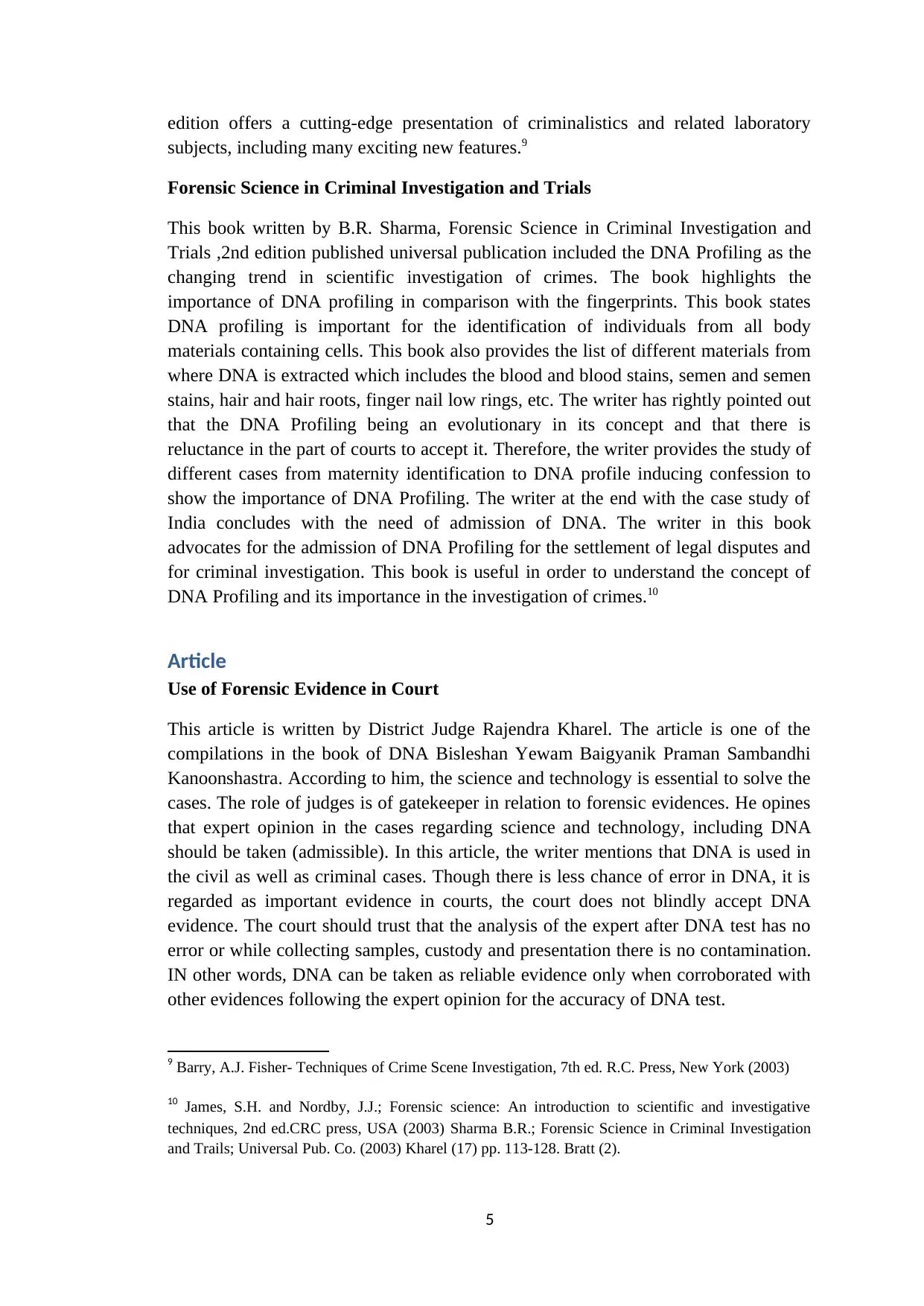
edition offers a cutting-edge presentation of criminalistics and related laboratory
subjects, including many exciting new features.9
Forensic Science in Criminal Investigation and Trials
This book written by B.R. Sharma, Forensic Science in Criminal Investigation and
Trials ,2nd edition published universal publication included the DNA Profiling as the
changing trend in scientific investigation of crimes. The book highlights the
importance of DNA profiling in comparison with the fingerprints. This book states
DNA profiling is important for the identification of individuals from all body
materials containing cells. This book also provides the list of different materials from
where DNA is extracted which includes the blood and blood stains, semen and semen
stains, hair and hair roots, finger nail low rings, etc. The writer has rightly pointed out
that the DNA Profiling being an evolutionary in its concept and that there is
reluctance in the part of courts to accept it. Therefore, the writer provides the study of
different cases from maternity identification to DNA profile inducing confession to
show the importance of DNA Profiling. The writer at the end with the case study of
India concludes with the need of admission of DNA. The writer in this book
advocates for the admission of DNA Profiling for the settlement of legal disputes and
for criminal investigation. This book is useful in order to understand the concept of
DNA Profiling and its importance in the investigation of crimes.10
Article
Use of Forensic Evidence in Court
This article is written by District Judge Rajendra Kharel. The article is one of the
compilations in the book of DNA Bisleshan Yewam Baigyanik Praman Sambandhi
Kanoonshastra. According to him, the science and technology is essential to solve the
cases. The role of judges is of gatekeeper in relation to forensic evidences. He opines
that expert opinion in the cases regarding science and technology, including DNA
should be taken (admissible). In this article, the writer mentions that DNA is used in
the civil as well as criminal cases. Though there is less chance of error in DNA, it is
regarded as important evidence in courts, the court does not blindly accept DNA
evidence. The court should trust that the analysis of the expert after DNA test has no
error or while collecting samples, custody and presentation there is no contamination.
IN other words, DNA can be taken as reliable evidence only when corroborated with
other evidences following the expert opinion for the accuracy of DNA test.
9 Barry, A.J. Fisher- Techniques of Crime Scene Investigation, 7th ed. R.C. Press, New York (2003)
10 James, S.H. and Nordby, J.J.; Forensic science: An introduction to scientific and investigative
techniques, 2nd ed.CRC press, USA (2003) Sharma B.R.; Forensic Science in Criminal Investigation
and Trails; Universal Pub. Co. (2003) Kharel (17) pp. 113-128. Bratt (2).
5
subjects, including many exciting new features.9
Forensic Science in Criminal Investigation and Trials
This book written by B.R. Sharma, Forensic Science in Criminal Investigation and
Trials ,2nd edition published universal publication included the DNA Profiling as the
changing trend in scientific investigation of crimes. The book highlights the
importance of DNA profiling in comparison with the fingerprints. This book states
DNA profiling is important for the identification of individuals from all body
materials containing cells. This book also provides the list of different materials from
where DNA is extracted which includes the blood and blood stains, semen and semen
stains, hair and hair roots, finger nail low rings, etc. The writer has rightly pointed out
that the DNA Profiling being an evolutionary in its concept and that there is
reluctance in the part of courts to accept it. Therefore, the writer provides the study of
different cases from maternity identification to DNA profile inducing confession to
show the importance of DNA Profiling. The writer at the end with the case study of
India concludes with the need of admission of DNA. The writer in this book
advocates for the admission of DNA Profiling for the settlement of legal disputes and
for criminal investigation. This book is useful in order to understand the concept of
DNA Profiling and its importance in the investigation of crimes.10
Article
Use of Forensic Evidence in Court
This article is written by District Judge Rajendra Kharel. The article is one of the
compilations in the book of DNA Bisleshan Yewam Baigyanik Praman Sambandhi
Kanoonshastra. According to him, the science and technology is essential to solve the
cases. The role of judges is of gatekeeper in relation to forensic evidences. He opines
that expert opinion in the cases regarding science and technology, including DNA
should be taken (admissible). In this article, the writer mentions that DNA is used in
the civil as well as criminal cases. Though there is less chance of error in DNA, it is
regarded as important evidence in courts, the court does not blindly accept DNA
evidence. The court should trust that the analysis of the expert after DNA test has no
error or while collecting samples, custody and presentation there is no contamination.
IN other words, DNA can be taken as reliable evidence only when corroborated with
other evidences following the expert opinion for the accuracy of DNA test.
9 Barry, A.J. Fisher- Techniques of Crime Scene Investigation, 7th ed. R.C. Press, New York (2003)
10 James, S.H. and Nordby, J.J.; Forensic science: An introduction to scientific and investigative
techniques, 2nd ed.CRC press, USA (2003) Sharma B.R.; Forensic Science in Criminal Investigation
and Trails; Universal Pub. Co. (2003) Kharel (17) pp. 113-128. Bratt (2).
5
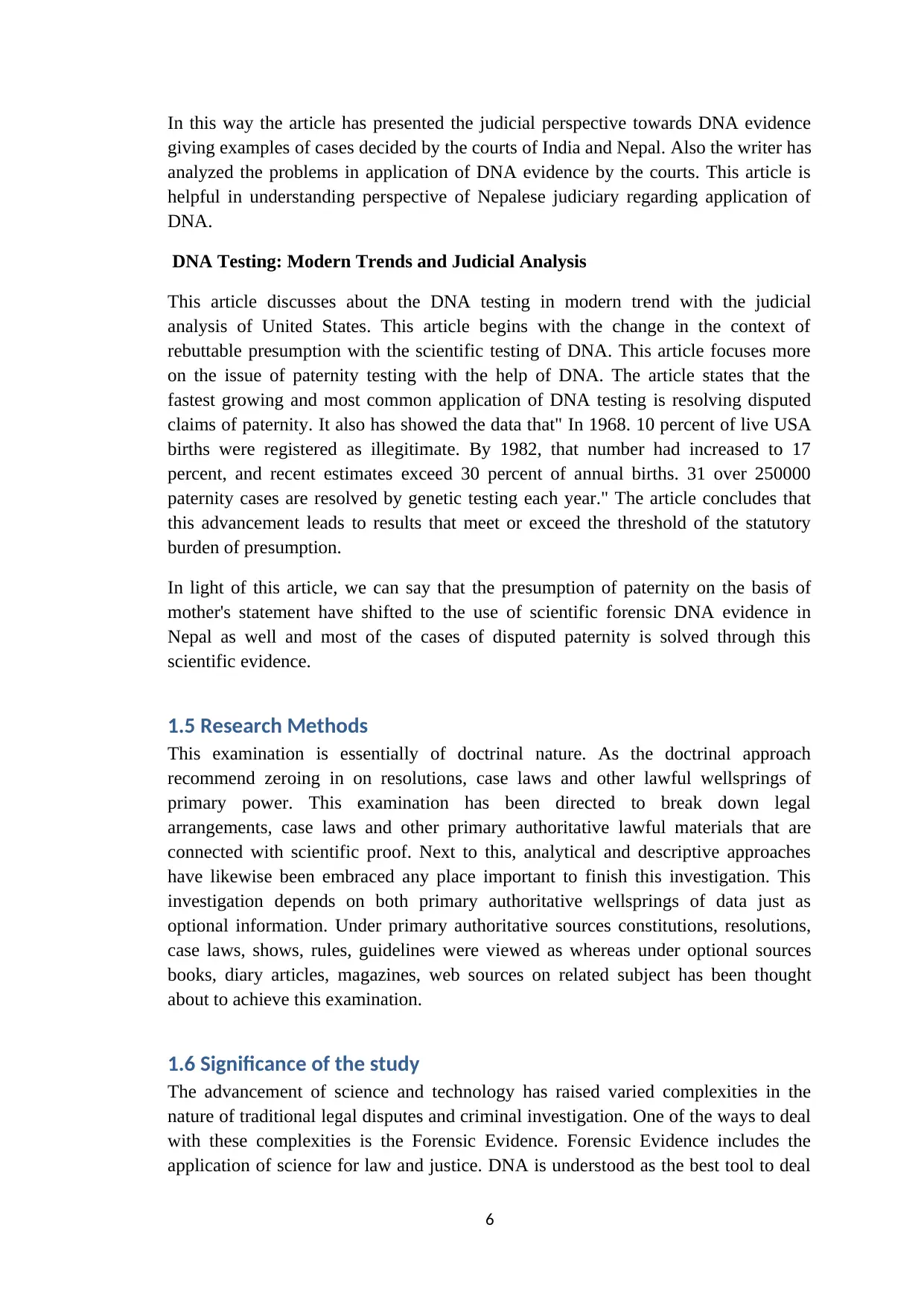
In this way the article has presented the judicial perspective towards DNA evidence
giving examples of cases decided by the courts of India and Nepal. Also the writer has
analyzed the problems in application of DNA evidence by the courts. This article is
helpful in understanding perspective of Nepalese judiciary regarding application of
DNA.
DNA Testing: Modern Trends and Judicial Analysis
This article discusses about the DNA testing in modern trend with the judicial
analysis of United States. This article begins with the change in the context of
rebuttable presumption with the scientific testing of DNA. This article focuses more
on the issue of paternity testing with the help of DNA. The article states that the
fastest growing and most common application of DNA testing is resolving disputed
claims of paternity. It also has showed the data that" In 1968. 10 percent of live USA
births were registered as illegitimate. By 1982, that number had increased to 17
percent, and recent estimates exceed 30 percent of annual births. 31 over 250000
paternity cases are resolved by genetic testing each year." The article concludes that
this advancement leads to results that meet or exceed the threshold of the statutory
burden of presumption.
In light of this article, we can say that the presumption of paternity on the basis of
mother's statement have shifted to the use of scientific forensic DNA evidence in
Nepal as well and most of the cases of disputed paternity is solved through this
scientific evidence.
1.5 Research Methods
This examination is essentially of doctrinal nature. As the doctrinal approach
recommend zeroing in on resolutions, case laws and other lawful wellsprings of
primary power. This examination has been directed to break down legal
arrangements, case laws and other primary authoritative lawful materials that are
connected with scientific proof. Next to this, analytical and descriptive approaches
have likewise been embraced any place important to finish this investigation. This
investigation depends on both primary authoritative wellsprings of data just as
optional information. Under primary authoritative sources constitutions, resolutions,
case laws, shows, rules, guidelines were viewed as whereas under optional sources
books, diary articles, magazines, web sources on related subject has been thought
about to achieve this examination.
1.6 Significance of the study
The advancement of science and technology has raised varied complexities in the
nature of traditional legal disputes and criminal investigation. One of the ways to deal
with these complexities is the Forensic Evidence. Forensic Evidence includes the
application of science for law and justice. DNA is understood as the best tool to deal
6
giving examples of cases decided by the courts of India and Nepal. Also the writer has
analyzed the problems in application of DNA evidence by the courts. This article is
helpful in understanding perspective of Nepalese judiciary regarding application of
DNA.
DNA Testing: Modern Trends and Judicial Analysis
This article discusses about the DNA testing in modern trend with the judicial
analysis of United States. This article begins with the change in the context of
rebuttable presumption with the scientific testing of DNA. This article focuses more
on the issue of paternity testing with the help of DNA. The article states that the
fastest growing and most common application of DNA testing is resolving disputed
claims of paternity. It also has showed the data that" In 1968. 10 percent of live USA
births were registered as illegitimate. By 1982, that number had increased to 17
percent, and recent estimates exceed 30 percent of annual births. 31 over 250000
paternity cases are resolved by genetic testing each year." The article concludes that
this advancement leads to results that meet or exceed the threshold of the statutory
burden of presumption.
In light of this article, we can say that the presumption of paternity on the basis of
mother's statement have shifted to the use of scientific forensic DNA evidence in
Nepal as well and most of the cases of disputed paternity is solved through this
scientific evidence.
1.5 Research Methods
This examination is essentially of doctrinal nature. As the doctrinal approach
recommend zeroing in on resolutions, case laws and other lawful wellsprings of
primary power. This examination has been directed to break down legal
arrangements, case laws and other primary authoritative lawful materials that are
connected with scientific proof. Next to this, analytical and descriptive approaches
have likewise been embraced any place important to finish this investigation. This
investigation depends on both primary authoritative wellsprings of data just as
optional information. Under primary authoritative sources constitutions, resolutions,
case laws, shows, rules, guidelines were viewed as whereas under optional sources
books, diary articles, magazines, web sources on related subject has been thought
about to achieve this examination.
1.6 Significance of the study
The advancement of science and technology has raised varied complexities in the
nature of traditional legal disputes and criminal investigation. One of the ways to deal
with these complexities is the Forensic Evidence. Forensic Evidence includes the
application of science for law and justice. DNA is understood as the best tool to deal
6
⊘ This is a preview!⊘
Do you want full access?
Subscribe today to unlock all pages.

Trusted by 1+ million students worldwide
1 out of 48
Your All-in-One AI-Powered Toolkit for Academic Success.
+13062052269
info@desklib.com
Available 24*7 on WhatsApp / Email
![[object Object]](/_next/static/media/star-bottom.7253800d.svg)
Unlock your academic potential
Copyright © 2020–2025 A2Z Services. All Rights Reserved. Developed and managed by ZUCOL.